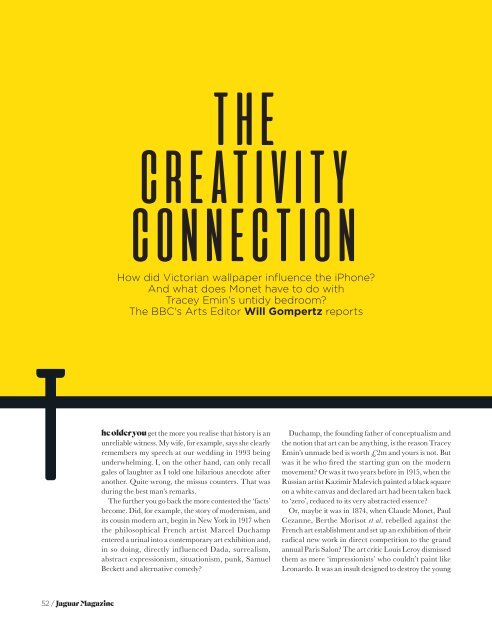Jaguar Magazine #08
In this issue, we explore the art of creativity from the Brazilian masters who devised the graceful art of Capoeira, to the Irish artists mixing new culture with old. You will also discover the creative line that links Victorian wallpaper to the iPhone. While the multi-talented actor and performer, Riz Ahmed, explains why it is the right time to reveal his true self to the world.
In this issue, we explore the art of creativity from the Brazilian masters who devised the graceful art of Capoeira, to the Irish artists mixing new culture with old. You will also discover the creative line that links Victorian wallpaper to the iPhone. While the multi-talented actor and performer, Riz Ahmed, explains why it is the right time to reveal his true self to the world.
Create successful ePaper yourself
Turn your PDF publications into a flip-book with our unique Google optimized e-Paper software.
Arts<br />
THE<br />
CREATIVITY<br />
CONNECTION<br />
How did Victorian wallpaper influence the iPhone?<br />
And what does Monet have to do with<br />
Tracey Emin's untidy bedroom?<br />
The BBC's Arts Editor Will Gompertz reports<br />
MARCEL DUCHAMP, FOUNTAIN (1917), GALLERY SCHWARZ EDITION, 1964 © ASSOCIATION<br />
MARCEL DUCHAMP / ADAGP, PARIS AND DACS, LONDON 2020<br />
Punk art<br />
Though controversial in<br />
1917, Duchamp's Fountain<br />
is a hugely powerful work<br />
The older you get the more you realise that history is an<br />
unreliable witness. My wife, for example, says she clearly<br />
remembers my speech at our wedding in 1993 being<br />
underwhelming. I, on the other hand, can only recall<br />
gales of laughter as I told one hilarious anecdote after<br />
another. Quite wrong, the missus counters. That was<br />
during the best man’s remarks.<br />
The further you go back the more contested the ‘facts’<br />
become. Did, for example, the story of modernism, and<br />
its cousin modern art, begin in New York in 1917 when<br />
the philosophical French artist Marcel Duchamp<br />
entered a urinal into a contemporary art exhibition and,<br />
in so doing, directly influenced Dada, surrealism,<br />
abstract expressionism, situationism, punk, Samuel<br />
Beckett and alternative comedy?<br />
Duchamp, the founding father of conceptualism and<br />
the notion that art can be anything, is the reason Tracey<br />
Emin’s unmade bed is worth £2m and yours is not. But<br />
was it he who fired the starting gun on the modern<br />
movement? Or was it two years before in 1915, when the<br />
Russian artist Kazimir Malevich painted a black square<br />
on a white canvas and declared art had been taken back<br />
to ‘zero’, reduced to its very abstracted essence?<br />
Or, maybe it was in 1874, when Claude Monet, Paul<br />
Cezanne, Berthe Morisot et al. rebelled against the<br />
French art establishment and set up an exhibition of their<br />
radical new work in direct competition to the grand<br />
annual Paris Salon? The art critic Louis Leroy dismissed<br />
them as mere ‘impressionists’ who couldn’t paint like<br />
Leonardo. It was an insult designed to destroy the young<br />
upstarts, but instead it turned them into the most famous<br />
modern art brand in the world.<br />
An equally credible start date could be 1863, the year<br />
the poet and critic Charles Baudelaire wrote his famous<br />
essay The Painter of Modern Life, in which he urged the<br />
pioneering artists of Paris to cease choosing ancient<br />
mythology and religious figures as their subjects and<br />
focus instead on the grubby, exciting realities of urban<br />
life in their cosmopolitan city.<br />
The ink had barely dried on his paper when Édouard<br />
Manet produced a controversial painting of a reclining<br />
female nude, Olympia, which appalled the stuffed shirts<br />
at the Academy – it depicted a local prostitute, not a<br />
Greek goddess – but inspired the avant-garde who were<br />
thrilled by its sketchy audacity and flat blocks of colour.<br />
It is a great picture, but I don’t think it heralded the<br />
beginning of the story of modernism. For that we need<br />
to go back a further two years and across the Channel.<br />
Hidden away in Holborn – the no-man’s land between<br />
London’s West End and City – is Red Lion Square,<br />
where, in April 1861, an interior design firm called Morris,<br />
Marshall, Faulkner & Co opened for business. Its<br />
creative driving force was a bearded mediaevalist called<br />
William Morris (not to be confused with William Morris<br />
of Morris Motors).<br />
He loathed the age of industrialisation through which<br />
he was living. His hero was art critic John Ruskin, whose<br />
book The Stones of Venice argued that mechanical massproduction<br />
had caused the ‘degradation of the workman’,<br />
turning him into a mere cog in a machine.<br />
52 / <strong>Jaguar</strong> <strong>Magazine</strong><br />
<strong>Jaguar</strong> <strong>Magazine</strong> /









